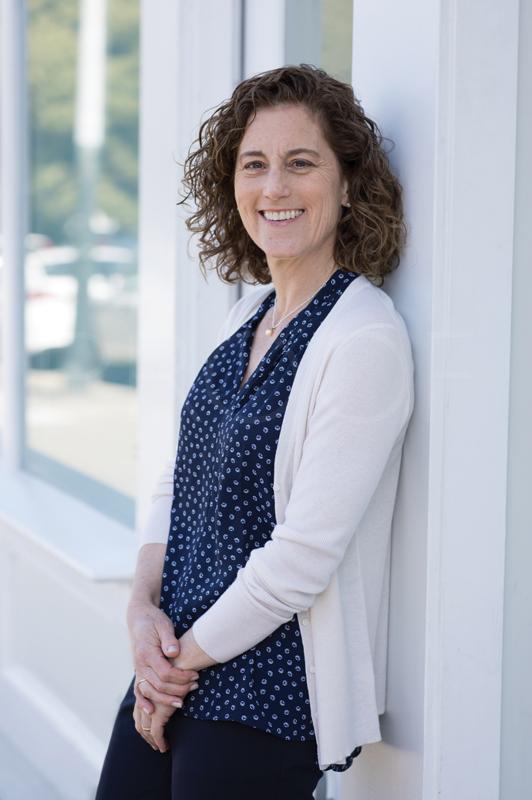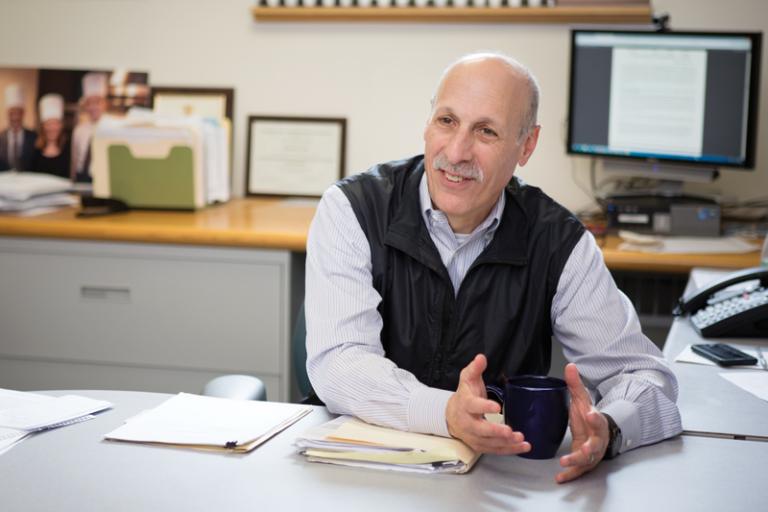Shelter in Place
For the rural elderly, healthy aging often means remaining at home
- 11 minute read
- Feature

For some, home means the smell of the desert after a winter rain. For others, it might be the sound of spring peepers; the taste of the summer’s first tomato, fresh from the garden and still warm from the sun; or the sight of gold-hued tamaracks through a frost-touched window. More than one-quarter of the 50 million older adults in the United States live in rural areas or small towns, and for many of them, aging well means aging where the sights, sounds, and tastes of home are renewed with each new season—not locked in memories or frozen in photos that hang on walls far from the places they once called home.
I can’t tell you how many people will say they will take whatever risks necessary—even dying, even spending hours on the floor without help—just to stay in their home,” says Louise Aronson ’92, a professor of geriatrics at the University of California, San Francisco.
Unfortunately, that home may be hours away from a cardiac center, completely isolated from high-quality long-term care facilities, and bereft of local caregivers trained to aid the elderly.
As a demographic group, Aronson notes, older adults are the highest consumers of health care, the most likely to become hospitalized, the most likely to take medications and to have adverse drug reactions, and the most likely to be harmed by medical care.
Providing comprehensive, affordable care for this medically complex population, particularly in economically strapped rural areas, presents a tough challenge that clinical and policy experts say will require creative solutions. That challenge is compounded by the fact that as people age, they often face multiple chronic health problems without access to appropriate medical expertise and needed social supports. Older adults need access to acute and long-term health care, and some may also require help with transportation, nutrition, and managing the physical and cognitive demands of daily life. And they need these supports in ways that don’t diminish their sense of self.

Hearing and Listening
In The Heirs of General Practice, the journalist John McPhee describes the complex interweaving of clinical, personal, cultural, political, and economic factors that affect the health of patients of several family medicine practitioners in rural Maine. Aronson says that the book provided her with insights into primary care that weren’t always in medical textbooks, insights that also have relevance to her work in geriatrics. Perhaps most relevant is the importance of thinking about her patients as members of families and communities—and as individuals with histories and intensely personal visions of how they want to live their lives and what they do and don’t want from medical care as they age.
This holistic way of thinking about health and wellness contrasts starkly with the mindset and funding streams that propel our health system, Aronson says. The current system, she says, too often focuses on diseases and organs instead of on health and people, and it disproportionally values treating acute illnesses with high-tech interventions rather than implementing proven prevention strategies that promote health.
“We’re so focused on biology we sometimes forget about caring and meaning,” she says. If treating patients with a particular class of drugs means that they lose their sense of balance and their ability to walk, it’s better medicine to back off on dose or to try a different treatment so they can still exercise, work, and function in daily life rather than focus on getting their biomarkers into some textbook range of normal, Aronson adds. By the same token, if a patient chooses to stay in their rural home and live independently, it may be necessary to prioritize the older adult’s sense of independence over family members’ wishes for a safer environment and better proximity to medical care.
Gray Tide
“Over the next twenty years,” says Richard Frank, the Margaret T. Morris Professor of Health Economics in the Department of Health Care Policy at HMS, “the fastest growing sector of the U.S. population will be those age 80 and above.” Today, according to the U.S. Census Bureau, more than one in fifty rural residents is over the age of 80.
Caring for people in that age group is complicated, says Frank, who has worked on aging and disability in the U.S. Department of Health and Human Services, most recently from 2014 to 2016. As the department’s assistant secretary for planning and evaluation, Frank was the principal advisor to the HHS secretary in areas such as policy coordination, legislation development, strategic planning, policy research, evaluation, and economic analysis.
Combined with the acute health problems that so many older adults struggle with are the chronic conditions that often come with aging. Some conditions have direct medical relevance, such as declines in strength, mobility, and cognitive function. But others, for example the impediments to safe driving that come with changes in hearing and visual acuity, can affect health indirectly: If there’s no public transit where you live, driving is the only way you can get to a medical appointment.
Help Wanted
“We think of health care as being very local,” says David Grabowski, an HMS professor of health care policy who studies the economics of aging and long-term care. “You tend to go to the nursing home that’s up the street.”
In rural areas, there may be only one long-term care facility in a community or a single such facility serving a larger area, like a county. “That decreases the possibility there will be competitive forces to drive quality improvement,” says Grabowski. “If that facility is not providing high-quality care, there’s nowhere else seniors can take their business.”
Although the U.S. Bureau of Labor Statistics indicates that the health care and social assistance sector now employs 12 percent of workers in this country, a percentage projected to reach nearly 14 percent by 2024, Grabowski says there remains a real shortage of caregivers and others who can provide support for older adults. To illustrate, he points to a recent survey of long-term care facilities in Wisconsin. It estimated there were 11,500 unfilled caregiver jobs in that state alone.
And even if there were enough trained caregivers available, replacing long-term care facilities with home health aides presents other complications—distance, for one. Distance is such a recognized factor in providing care that some in the field have developed tools to track and reduce the time spent traveling from client to client.
Innovation Centers
A variety of technological and design advances have the potential to improve the lives and well-being of rural older adults. Aronson, who can almost hear Silicon Valley’s hum from her office, points to two potential innovations: mobile robots with communications tools that let older adults video chat with health professionals, caregivers, and family; order groceries for delivery; or call for help if they fall, and driverless cars, which could help older adults living in remote areas overcome some of their transportation challenges.
Coming less from the pages of science fiction and more from the pages of medical journals is telemedicine, which Grabowski says might be a useful tool for clinical visits or for practitioners wishing to share expertise. Yet video conferences will not help with personal care—bathing or dressing, for instance—and even pared-down smartphones with preprogrammed options could prove challenging for older adults, especially patients with cognitive impairments, such as dementia.
Instead of trying to connect patients directly with remote experts, Grabowski says, it might be best to equip caregivers with simple tools that can help both parties make the most of their time together. One example, he says, might be found in a project he is now undertaking. The project asks home health aides to complete a checklist after each client visit. The caregivers use the list to monitor changes in a patient’s physical or cognitive status—such as increased difficulty in walking—that may be clues to bigger problems.
Flagging these little changes and initiating appropriate follow-up care early, rather than waiting until the condition requires clinical care, could improve a patient’s well-being while also averting the need for more expensive care, Grabowski adds.

Local Perspectives
Whatever tools or aids are developed, they must be flexible enough to accommodate the profound differences in rural populations and the systems that serve their health care needs. There are, for instance, communities of Blacks that have worked the same land in Alabama for generations, while in Minnesota, there are communities of Laotian refugees who arrived within the past few decades. Established government systems, including the Department of Veterans Affairs and the Indian Health Service, can have parallels to other health systems but can also have points of divergence that make it difficult to transfer the innovations that work for one group to another group.
Even within a single ethnic group there can be vast cultural differences that must be considered when making clinical decisions. Consider the findings from a 2012 issue of the Journal of Gerontological Nursing. The researchers, three educators and health practitioners with personal and professional connections to native communities, found that discussions with elderly American Indians about moving to an assisted living facility needed to sensitively account for that elder’s past. Was the person forced to attend boarding schools as a child? Because many such schools stripped children of their native identity, the prospect of moving to an institution might conjure painful memories—and sink any medical recommendation for advanced care.
There are also profound differences in what constitutes a rural community, from near-urban counties surrounding big cities to remote, sparsely populated near-wilderness areas whose residents may be more than 100 miles from a hospital. The populations served can range from aging-in-place rural residents to snowbirds from northern cities who have chosen to spend their golden years in planned communities in warmer climes.
A variety of differences require a variety of solutions. Local initiatives, for example, can meet local needs, a line of thinking that underscores efforts ranging from having local tribal authorities coordinate care for their own older adults to creating the more than 600 Area Agencies on Aging. The latter were developed under the Older Americans Act of 1973 as the “on-the-ground organizations charged with helping vulnerable older adults live with independence and dignity in their homes and communities.”
Delivery Options
The landscape of health care for our aging population is no less complex than that for any other health care delivery system in the United States, with interconnecting public and private programs, providers, and institutions.
The Area Agencies on Aging coordinate a range of medical and social services important for the well-being of older adults in their designated communities, services such as education, home-delivered meals, transportation, and caregiver support. Many of these programs operate on limited budgets and could face cutbacks under proposed changes to social safety net programs such as the Patient Protection and Affordable Care Act.
According to Frank, other agencies outside HHS are exploring ways to provide older rural residents with the services they need to remain healthy. Working with the U.S. Department of Agriculture, some cooperative extension agents have begun incorporating outreach, monitoring, and education programs for older adults into their work. Veterans Affairs is developing Independence at Home, a program that would support in-home, long-term care to veterans for whom relocation to a facility is not a good option. Integrating these services and finding new ways to deliver care outside the traditional health care system will be an important part of building more accessible and comprehensive health care for the elderly in the rural regions of this country, Frank says.

Time to Rethink
The lack of caregivers skilled in treating older patients and the potential complexity of the medical needs that people over the age of 65 face are “a crisis in our country,” says Lewis Lipsitz, an HMS professor of medicine at Beth Israel Deaconess Medical Center and director of the Hebrew SeniorLife Institute for Aging Research.
Lipsitz began his career as a clinician-scientist studying how the complex interactions of physiological systems promote healthy cardiovascular and mobility functions and how these systems lose complexity with aging and disease. More recently he has focused his research on multisystem interventions, such as tai chi, which can restore the complexity of these systems and, in doing so, improve physical function. According to Lipsitz, this concept of healthy complexity may also apply to health care systems.
Because interactions with geriatric experts are rare and the care of elderly patients is complex, Lipsitz has helped pilot two models that bring geriatric expertise to nursing homes: a demonstration project supporting on-site “enhanced care and coordination providers” and a remote case-based video consultation program called ECHO-AGE. In a 2016 presentation at Brown University, Lipsitz reported that these models have been shown, respectively, to prevent avoidable hospitalizations and lower the cost of care and to reduce the use of physical restraints and antipsychotics.
Programs like these, along with various state and federal training programs and fellowships, can provide a foundation of geriatric expertise for physicians and other caregivers committed to working with rural elderly patients. Aronson notes that it’s vital for the medical community to radically rethink medical education and incorporate in it an understanding of the processes of aging and its biosocial effects. But a move to reconceptualize aging in our society should not only fall to clinicians. That effort, she points out, needs to be addressed by biomedical researchers, architects, product designers, community planners, policymakers, and other professionals who can help remake the way we serve people of all ages, wherever they live.
Images: Getty Images, Lee O’Dell (top), Margo Moritz (Aronson), John Soares